Sunscreen labels: How to read them
Importance of sunscreen and reading labels
Sunscreen is a crucial part of our daily skincare routine. It's our first line of defence against the harmful effects of the sun's rays. But, it's not just about slathering on any sunscreen. Understanding the labels on these products is equally important. It's the key to ensuring we're getting the right protection for our skin.
Brief overview of the article
In this article, we'll delve into the world of sunscreen labels. We'll demystify terms like SPF, broad-spectrum, water-resistant, and more. We'll also discuss the difference between chemical and mineral sunscreens, and what to look for in the list of active and inactive ingredients. We'll even touch on the importance of choosing reef-friendly options. By the end, you'll be a pro at reading sunscreen labels, armed with the knowledge to make the best choice for your skin and the environment. So, let's dive in and become sunscreen savvy!
Understanding sunscreen labels
The meaning of SPF
When you pick up a bottle of sunscreen, one of the first things you'll notice is the SPF or Sun Protection Factor. This number tells you how well the sunscreen can protect your skin from UVB rays, the kind of radiation that causes sunburn and contributes to skin cancer. For example, SPF 30 allows only 1/30th of the sun's UVB rays to reach your skin. This means it filters out approximately 97% of UVB radiation. It's important to note that high-SPF sunscreens do not offer complete protection. SPF 50 and 100 block about 98% and 99% of UVB rays, respectively. So, no matter the SPF, reapplication every two hours is crucial.
Broad-spectrum protection
Another term you'll often see is broad-spectrum. This is a critical feature to look for as it means the sunscreen protects against both UVA and UVB rays. While UVB rays burn the superficial layers of your skin, UVA rays penetrate deeper, causing premature ageing and contributing to skin cancer formation. A broad-spectrum sunscreen ensures you're shielded from both types of harmful radiation.
Water resistance
A water-resistant sunscreen is one that retains its stated SPF value after a certain time in water or while sweating. The label will specify whether the sunscreen remains effective for 40 minutes or 80 minutes during swimming or sweating. However, no sunscreen is fully water or sweat-proof, and reapplication is necessary after swimming, sweating, or towel drying.
Active ingredients: chemical vs. mineral sunscreens
Sunscreen products can be divided into two categories based on their active ingredients: chemical and mineral (or physical). Chemical sunscreens contain ingredients like oxybenzone and avobenzone, which absorb UV rays to reduce their penetration into the skin. On the other hand, mineral sunscreens use ingredients like zinc oxide and titanium dioxide to physically block and scatter the sun's rays. Both types have their pros and cons. For instance, chemical sunscreens are usually more comfortable to wear, but they might irritate sensitive skin. Mineral sunscreens are less likely to cause irritation but can leave a white cast on the skin.
Inactive ingredients
Don't overlook the inactive ingredients on the label. These components, while not directly responsible for sun protection, can influence the product's feel, stability, and how well it works with your skin. Look for products free of parabens, oils, and fragrances, especially if you have sensitive skin.

Dermatologist-tested vs. dermatologist-recommended
You might also see terms like dermatologist-tested or dermatologist-recommended. The former means a dermatologist has tested the product for skin tolerance, while the latter indicates that dermatologists would recommend the product to their patients. However, these terms are not regulated, so it's always best to consult with your own dermatologist or do a patch test before using a new product.
Face vs. body sunscreen
There's a difference between sunscreens designed for the face and those for the body. Facial sunscreens are typically non-comedogenic (won't clog pores), and they may contain less zinc oxide to avoid a white cast. They're also designed to work well with makeup and other skincare products. Body sunscreens, on the other hand, can be thicker and are often better for areas where sweating is an issue.
Environmental considerations: reef-friendly sunscreens
Lastly, consider the environmental impact of your sunscreen. Some sunscreens contain ingredients like oxybenzone and octinoxate, which are not reef-friendly. These chemicals can harm coral reefs by contributing to coral bleaching. So, if you're planning to swim in the ocean, opt for a sunscreen labelled as reef-friendly or reef-safe. These products are typically mineral-based and do not contain harmful chemicals. However, it's important to note that the terms "reef-friendly" and "reef-safe" are not regulated, so it's still a good idea to check the ingredient list. By choosing a reef-friendly sunscreen, you're not only protecting your skin but also doing your part to protect our oceans.
In the next section, we'll delve into additional considerations when choosing a sunscreen, including skin types, allergies, and children's sunscreen. Stay tuned!
Additional considerations and conclusion
Sunscreen and skin types
When choosing a sunscreen, it's essential to consider your skin type. For instance, if you have oily skin, look for a product labelled non-comedogenic, meaning it won't clog your pores. If you have dry skin, a moisturizing sunscreen might be a good fit. For sensitive skin, a mineral sunscreen is often less irritating than a chemical one. Remember, the best sunscreen is the one you'll wear every day, so find a product that feels good on your skin.
Sunscreen and allergies
If you have a history of skin allergies, be extra cautious when selecting a sunscreen. Some ingredients, particularly in chemical sunscreens, can cause allergic reactions. Look for products labelled as hypoallergenic or for sensitive skin. Also, consider doing a patch test: apply a small amount of the product on your inner forearm and wait 24 hours to see if any reaction occurs.
Sunscreen and children
Children's skin is more sensitive than adults', so it's crucial to choose a sunscreen specifically designed for them. Pediatricians often recommend mineral sunscreens for children because they're less likely to cause skin irritation. Also, look for a broad-spectrum, water-resistant sunscreen with an SPF of at least 30. Remember, sunscreen should not be used on babies under six months old. Instead, keep them in the shade and dress them in protective clothing.
Conclusion: choosing the right sunscreen
Choosing the right sunscreen can seem overwhelming with so many options and terms to understand. But now, you're equipped with the knowledge to make an informed decision. Remember, the best sunscreen is one that offers broad-spectrum protection, has an SPF of 30 or higher, and is water-resistant. Consider your skin type, any allergies, and whether the product is reef-friendly. And most importantly, find a sunscreen you like — because the best sunscreen is the one you'll use consistently.
Remember, sunscreen is just one part of a comprehensive sun protection plan. Don't forget to seek shade during peak sun hours and wear protective clothing. Here's to your skin health and enjoying the sun safely!
Sunscreen label faq
What does spf mean on sunscreen labels?
SPF stands for Sun Protection Factor. It's a measure of how well a sunscreen can protect your skin from UVB rays, which are the type of radiation that causes sunburn and contributes to skin cancer. For example, an SPF of 30 means that only 1/30th of the sun's UVB rays will reach your skin, blocking about 97% of UVB radiation.
What is the difference between chemical and mineral sunscreens?
Chemical sunscreens contain ingredients like oxybenzone and avobenzone, which absorb UV rays to reduce their penetration into the skin. On the other hand, mineral sunscreens use ingredients like zinc oxide and titanium dioxide to physically block and scatter the sun's rays. Chemical sunscreens are usually more comfortable to wear, but they might irritate sensitive skin. Mineral sunscreens are less likely to cause irritation but can leave a white cast on the skin.
What does "broad-spectrum" mean on a sunscreen label?
A sunscreen labelled as broad-spectrum protects against both UVA and UVB rays. While UVB rays burn the superficial layers of your skin, UVA rays penetrate deeper, causing premature ageing and contributing to skin cancer formation. A broad-spectrum sunscreen ensures you're shielded from both types of harmful radiation.
What does "water-resistant" mean on a sunscreen label?
A water-resistant sunscreen retains its stated SPF value after a certain time in the water or while sweating. The label will specify whether the sunscreen remains effective for 40 minutes or 80 minutes during swimming or sweating. However, no sunscreen is fully water or sweat-proof, and reapplication is necessary after swimming, sweating, or towel drying.
What is the difference between "dermatologist-tested" and "dermatologist-recommended"?
Dermatologist-tested means a dermatologist has tested the product for skin tolerance, while dermatologist-recommended indicates that dermatologists would recommend the product to their patients. However, these terms are not regulated, so it's always best to consult with your own dermatologist or do a patch test before using a new product.
What is a reef-friendly sunscreen?
A reef-friendly sunscreen is one that does not contain ingredients known to harm coral reefs, such as oxybenzone and octinoxate. These products are typically mineral-based and do not contain harmful chemicals. However, the terms "reef-friendly" and "reef-safe" are not regulated, so it's still a good idea to check the ingredient list. By choosing a reef-friendly sunscreen, you're not only protecting your skin but also doing your part to protect our oceans.
Sources:
- AAD: How to decode sunscreen lingo
- Byrdie: What to Look for on a Sunscreen Label—From Ingredients to Protection Level
- Dr. Sam Bunting: How to Read a Sunscreen Label
- Everyday Health: Sunscreen Glossary: Decoding Every SPF Term You Need to Know
- Forbes Health: How to Read a Sunscreen Label
- Skin Cancer Foundation: How to Read a Sunscreen Label

